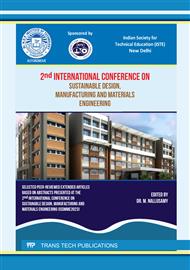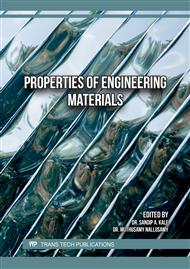[1]
Nanda Kumar, D., Raghul, K.S., Jeyakumar, R. : Study on Mechanical Behaviour of Bamboo Fiber Reinforced With Polymer Matrix Composite. International Journal of Innovative Research in Science, Engineering and Technology 5( 7), 66-70 (2016).
Google Scholar
[2]
Wani, R.S., Shitole, R.R. : Tensile Testing of Bamboo Fiber Reinforced Epoxy Composite. IOSR Journal of Mechanical and Civil Engineering, e-ISSN: 2278-1684, 7-11 (2017) .
DOI: 10.9790/1684-17010050711
Google Scholar
[3]
Bhoopathi, R., Ramesh, M., Deepa, C.: Fabrication and property evaluation of banana-hemp-glass Fiber reinforced composites, Procedia engineering 97, 2032-2041 (2014).
DOI: 10.1016/j.proeng.2014.12.446
Google Scholar
[4]
Ramesh, M., Palanikumar, K., Hemachandra Reddy, K. : Comparative evaluation on properties of hybrid glass Fiber-Sisal/jute Reinforced epoxy. Composite's proceeding engineering 51, 745-750 (2013).
DOI: 10.1016/j.proeng.2013.01.106
Google Scholar
[5]
S. Sridhar, S. Nandhakumar, M. Nallusamy, R. Maguteeswaran, Microstructural analysis and experimental investigation of mechanical properties of epoxy based hybrid composite reinforced with flax, sisal and luffa fibre, Journal of Ceramic Processing Research 23(4), 498-502
Google Scholar
[6]
Mulinari, D. R., Voorwald, H.J.C., Cioffi, M.O.H., Da Silva, M.L.C.P., Luz, S.M.: Preparation and properties of HDPE/sugarcane bagasse cellulose composites obtained for thermokinetic mixer. Carbohydr Polym, 75;317-320 (2009).
DOI: 10.1016/j.carbpol.2008.07.028
Google Scholar
[7]
Fatma Omrani, et. al.: Mechanical properties of flax-fibre-reinforced preforms and composites: Influence of the type of yarns on multiscale characterizations. Composites: Part A 93, 72–81 (2017).
DOI: 10.1016/j.compositesa.2016.11.013
Google Scholar
[8]
Mathew et al.: Composite of short coir fibers and natural rubber: effect of chemical modification, loading and orientation of fiber. Polymer, 39 (6), 1483 – 1491 (1998).
DOI: 10.1016/s0032-3861(97)00422-9
Google Scholar
[9]
Shreeram, B, Rajendran, I: Corrosion, Adhesion and Erosion study of MZ and ML system using Thermal Plasma. International Journal of Heavy Vehicle Systems 25 (3-4), 406-418 (2018).
DOI: 10.1504/ijhvs.2018.094831
Google Scholar
[10]
K. Murugan, S. Venkatesh, R. Thirumalai, S. Nandhakumar, Fabrication and investigations of kenaf fiber and ba-nana fiber reinforced composite material,Materials Today: Proceedings,Volume 37, Part 2,2021,Pages 110-114,ISSN 2214-7853
DOI: 10.1016/j.matpr.2020.04.540
Google Scholar



